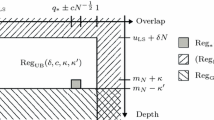Abstract
We characterize the topology of the phase space of the Berlin-Kac spherical model in the context of the so called Topological Hypothesis, for spins lying in hypercubic lattices of dimension d. For zero external field we are able to characterize the topology exactly, up to homology. We find that, even though there is a continuum of changes in the topology of the corresponding manifolds, for d ≥ 3 there are abrupt discontinuities in some topological functions that could be good candidates to associate with the phase transitions that occur at the thermodynamic level. We show however that these changes do not coincide with the phase transitions and conversely, that no topological discontinuity can be associated to the points where the phase transitions take place. At variance with what happens in the Mean Field version of this same model, we show that these abrupt topological changes are accessible thermodynamically. We conclude that, even in short range systems, the topological mechanism does not seem to be responsible for the triggering of a phase transition. We also analyze the case of spins connected to a macroscopic number of (but not all) neighbors, and find that, similar to the results found for the fully connected version, in this case the topological hypothesis seems to hold: the phase transition coincides with an accumulation point of the topological changes present in configuration space. The question of the ensemble equivalence in the short range spherical model is also considered.
Similar content being viewed by others
References
C. N. Yang and T. D. Lee, Phys. Rev. 87: 404 (1952); T. D. Lee and C. N. Yang, Phys. Rev. 87: 410 (1952).
Within the A2 canonical ensemble, the loss of analyticity in the free energy function is guaranteed to happen only for N→∞, whereas, within the microcanonical ensemble, the entropy can present non-analyticity points already at finite N, and PTs can be thus found in finite systems.
L. Casetti, M. Pettini, E. G. D. Cohen, Phys. Rep. 337: 237 (2000).
L. Casetti, M. Pettini, E. G. D. Cohen, J. Stat. Phys. 111: 1091 (2003).
L. Angelani, L. Casetti, M. Pettini, G. Ruocco and F. Zamponi, Europhys. Lett. 62: 775 (2003); idem, Phys. Rev. E 71: 036152 (2005).
M. Kastner, Physica A 359: 447 (2006); M. Kastner and O. Schnetz, preprint cond-mat/0503046.
R. Franzosi, M. Pettini and L. Spinelli, Phys. Rev. Lett. 84: 2774 (2000).
A. Andronico, L. Angelani, G. Ruocco, and F. Zamponi, Phys. Rev. E 70: 041101 (2004).
D. A. Garanin, R. Schilling, and A. Scala, Phys. Rev. E 70: 036125 (2004).
J. Milnor, Morse Theory (Annals of Mathematics Study No. 51, Princeton University Press, 1962).
P. Grinza and A. Mossa, Phys. Rev. Lett. 92: 158102 (2004).
M. Kastner, Phys. Rev. Lett. 93: 150601 (2004).
R. Franzosi and M. Pettini, Phys. Rev. Lett. 92: 060601 (2004); R. Franzosi, M. Pettini, and L. Spinelli, math-ph/0305032.
A. C. Ribeiro-Teixeira and D. A. Stariolo, Phys. Rev. E 70: 16113 (2004).
S. Risau-Gusman, A. C. Ribeiro-Teixeira and D. A. Stariolo, Phys. Rev. Lett. 95: 145702 (2005).
T. H. Berlin and M. Kac, Phys. Rev. 86: 821 (1952).
G. S. Joyce, Phys. Rev. 146: 349 (1966).
M. N. Barber and M. E. Fisher, Ann. Phys. 77: 1 (1973).
G. S. Joyce, in Phase Transitions and Critical Phenomena. ed. C. Domb and M. S. Green, Academic, New York, Vol. 2, p. 375 (1972).
P. R. Gerber and M. E. Fisher, Phys. Rev. B 10: 4697 (1974).
A. Hatcher, Algebraic Topology, (Cambridge University Press, Cambridge, 2002).
R. Bott, Bull. Amer. Math. Soc. 7: 331 (1982)
The continuity of the potential on the sphere implies that Mv0+e is an N-dimensional disk. As all Mvmust contain this disk, they are also N-dimensional.
Two objects are homotopy equivalent if they can be continuously deformed into the same thing. As this retraction is not required to be invertible, homotopy equivalence is weaker than topological equivalence. Nevertheless, many topological invariants are preserved in homotopy equivalent objects. The precise definition of a deformation retract is given in the Appendix.
The translational symmetry requirement guarantees that the connection matrix is a circulant one. Using the usual expressions for the eigenvalues of circulant matrices, it can be shown that if the interactions are as mentioned the eigenvalues satisfy limN→∞Λj+1 - Λj =0,∀ j, in the one dimensional case. The same can be done for all indices in higher dimensional systems.
H. Behringer, J. Stat. Mech. P06014 (2005).
H. Touchette, R. S. Ellis and B. Turkington, Physica A 340: 138–146 (2004).
G. S. Joyce and I. J. Zucker, J. Phys. A: Math. Gen. 34: 7349–7354 (2001).
The function fμ rewritten as fμ remains finite at μ=.
F. Bouchet and J. Barré, J. Stat. Phys. 118: 1073 (2005).
Ingo Hahn and Michael Kastner, in Phys. Rev. E 72: 056134 (2005) and preprint cond-mat/0509206, to appear in European Phys. J. B.
F. A. Tamarit, G. Maglione, D. A. Stariolo, and C. Anteneodo, Phys. Rev. E 71: 036148 (2005).
J. Kurchan and L. Laloux, J. Phys. A 29: 1929 (1996).
A. Cavagna, I. Giardina and G. Parisi, Phys. Rev. B 57: 11251 (1998).
T. Grigera, A. Cavagna, I. Giardina, and G. Parisi, Phys. Rev. Lett. 88: 55502 (2002).
L. Angelani, R. Di Leonardo, G. Ruocco, A. Scala and F. Sciortino, Phys. Rev. Lett. 85: 5356 (2000).
I. S. Gradshteyn and I. M. Ryzhik, Table of Integrals, Series and Products, (5th ed., San Diego, CA: Academic, 1994).
R. C. Buck, Advanced Calculus, (Mc Graw Hill, New York, 1978).
Author information
Authors and Affiliations
Corresponding author
Rights and permissions
About this article
Cite this article
Risau-Gusman, S., Ribeiro-Teixeira, A.C. & Stariolo, D.A. Topology and Phase Transitions: The Case of the Short Range Spherical Model. J Stat Phys 124, 1231–1253 (2006). https://doi.org/10.1007/s10955-006-9178-8
Received:
Accepted:
Published:
Issue Date:
DOI: https://doi.org/10.1007/s10955-006-9178-8



